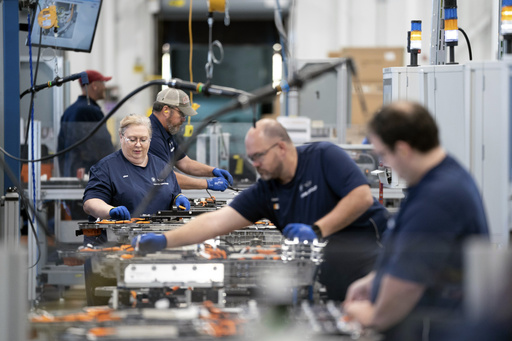Washington – The job market in the United States saw a notable improvement in November, with an addition of 227,000 jobs, marking a significant recovery from the previous month that was influenced by strikes and hurricanes, which had negatively impacted employer payrolls.
This growth in hiring was a clear contrast to the limited gain of merely 36,000 jobs recorded in October. The government also adjusted its job growth estimates for September and October upward by a total of 56,000. The latest report from the Labor Department revealed that while the unemployment rate increased from 4.1% in October to a low 4.2% in November, hourly wages experienced a 0.4% rise from October to November and a 4% increase year-over-year, exceeding economists’ expectations.
The November job report further demonstrated the resilience of the U.S. job market, despite the notable deceleration from the hiring boom seen during 2021-2023, which was a result of recovering from the pandemic-related economic downturn. This gradual slowdown can be attributed partly to the elevated interest rates set by the Federal Reserve as part of its strategy to manage inflation.
Throughout 2022 and 2023, the Federal Reserve raised interest rates 11 times. The economy has surprisingly continued to grow despite an increase in borrowing costs for both consumers and businesses. However, the job market has shown signs of deceleration since the beginning of this year.
Economist Thomas Simons from Jefferies pointed out that the recovery from the effects of strikes and hurricanes in October likely contributed around 60,000 jobs to last month’s payroll figures, indicating the market’s capacity to accommodate most job seekers without triggering inflationary concerns.
The notable increase of 227,000 jobs in November was derived from a survey conducted by the Labor Department targeting employers. In a separate household survey that determines the unemployment rate, there was a discernible decline as the number of unemployed individuals increased by 161,000, and the workforce participation rate fell for a second consecutive month.
Economists highlighted that the job gains were rather concentrated, with three sectors—healthcare and social assistance; leisure and hospitality; and government—responsible for 70% of the jobs added. Additionally, the manufacturing sector experienced a gain of 22,000 jobs in November, largely attributed to the conclusion of strikes at Boeing and elsewhere. In contrast, the retail industry lost 28,000 jobs.
Julia Pollak, chief economist at ZipRecruiter, cautioned against misreading the seemingly positive number of 227,000 job additions, noting that the average job gains over October and November stands at a modest 132,000 per month. She further expressed that this report fails to provide substantial evidence of a robust rebound in the labor market.
Regardless, Americans as a whole are experiencing an unusual level of job security. The government indicated that job layoffs dropped to only 1.6 million in October, representing the lowest figure observed in the two decades prior to the pandemic. Simultaneously, there was an uptick in job openings from a near three-and-a-half-year low, signaling that businesses still seek new hires even amidst a slowdown in hiring activity.
The broader economy continues to display resilience. Elevated borrowing costs resulting from the Fed’s rate hikes were anticipated to precipitate a recession; however, the economy sustained growth as consumer spending remained robust and employers continued to recruit new workers.
From July to September, the economy expanded at an annual rate of 2.8%, fueled by significant consumer spending. In fact, annual economic growth exceeded 2% in eight of the last nine quarters, while inflation has receded from a high of 9.1% in June 2022 to just 2.6% last month. Nonetheless, many Americans remain frustrated with the persistent high prices during the Biden-Harris administration, prompting some voters to favor Donald Trump in the recent elections.
Although job losses are relatively low, individuals who do face unemployment are finding it increasingly difficult to secure new positions, as the average duration of unemployment reached 23.7 weeks last month—the longest stretch in two and a half years. The advances made in taming inflation and the deceleration of hiring, which eased pressure on companies to increase wages and prices, compelled the Federal Reserve to lower its key interest rates in September and again last month. Another rate cut is anticipated during the Fed’s upcoming meeting on December 17-18.
Pollak noted that there are some grounds for optimism concerning the job market, emphasizing that wage growth has consistently outpaced inflation for the past two years, thereby enhancing the purchasing power of Americans. Furthermore, the potential decrease in borrowing rates may encourage future spending and hiring. She declared, “There are all kinds of mounting tailwinds that should propel this labor market forward.”
However, certain businesses are exercising caution. Chris Butler, CEO of the National Tree Company, which specializes in artificial holiday trees, wreaths, and garlands, mentioned he is taking a careful approach to recruitment, as the company copes with lower consumer spending. Like many competitors, National Tree has offered substantial discounts as consumers have reduced discretionary spending. Butler is also keeping an eye on the potential imposition of significant new tariffs that President-elect Trump has hinted at introducing on imports from countries like China.
Despite sourcing a large portion of its products from China, National Tree is transitioning more of its production to Vietnam and Cambodia, with plans to completely exit China by 2026 in anticipation of Trump’s presidency. Looking ahead to 2025, Butler projected, “we’ll probably add a few roles. But it’s certainly not going to be a hiring bonanza.”



